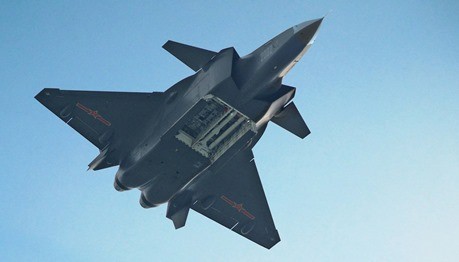China has been accused by some countries of designing its military aircraft by copying the fighters of other countries, after an Internet user published a black and white photograph of the "number 2013" prototype of the Chengdu J-20, China's first stealth fighter on a test flight, Sina's military news Web portal reported.
European and U.S. media said that the Chengdu J-20 is a rip-off of the U.S. F-22 stealth fighter, while Japanese media suggested that the design concept of the J-20 was taken from the Soviet Union's MiG-1.44 technology demonstrator, a project that was later abandoned.
According to U.S. magazine Wired, the Xian Y-20 large military transport aircraft has "the same wide swept wing and T-shaped tail as the Boeing-made C-17, blueprints of which China obtained several years ago through a spy working for the Chicago-based plane manufacturer."
Other overseas media outlets have also noted that the Harbin Z-20, a 10-ton multirole helicopter developed at China's 602nd Aircraft Design Institute, is a clear copy of the S-70C2, the export version of the U.S. Sikorsky UH-60 Black Hawk.
According to the website, if judgment will only be based on external appearance, then the aircraft of many countries can also be considered rip-offs, as it pointed out that Israel's IAI Lavi has striking resemblance to the French Dassault Mirage III, and the Soviet Tu-160 strategic bomber resembles a larger version of the U.S. B-1B. It added that even the U.S. F-15 fighter resembles the Soviet Mikoyan-Gurevich MiG-25.
The website said that in order to establish the degree of creativity, one has to look beyond appearances, particularly the differences in the interior design and weapons systems. These aspects of the J-20, Y-20 and Z-20 showed that they are not just rip-offs, the website claimed.
The J-20, a fourth-generation stealth heavy fighter, uses two WS-10B turbofan engines developed in Shenyang. It has divert-less supersonic inlets (DSI) on both sides, an all-moving vertical tail and a canard wing configuration. The J-20 will be used by the PLA for air and marine protection and will reportedly get the NATO designation "Fire Tooth."
The J-20 is expected to meet the PLA Air Force's combat needs by 2020. However, it must be equipped with the WS-15 turbofan engine first to make it capable of supersonic cruise.
It is estimated that the J-20 fighter will weigh 16-19 tonnes empty, with a maximum take-off weight of 36 tons and carry a weapon payload of 10 tons. Its body length measures 21 meters, with a wing span of 13m and a maximum flight speed of Mach 2.2. Its cruise speed will likely be around Mach 1.6. It will likely have a maximum altitude of 20,000m and a range of 4,500km (carrying two subsidiary fuel tanks).
The J-20 will have a combat radius of 1,500km and its main weapon systems will be the PL-21 long-range active radar air-to-air missile, the PL-12 medium-range active radar air-to-air missile, the PL-10 radar-homing medium-range air-to-air missile, and the PL-8 infrared-guided air-to-air missile, as well as homing weapons and free-fall general purpose bombs. It will be flown by a lone pilot and has a radar cross-section (RCS) of 0.05 square meters with infrared signal similar in strength to the F-35.
The PLA Air Force is expected to use the aircraft in 2018.
On the other hand, the Y-20 has a conventional configuration and earned the nickname "Chubby Girl" for its short and stubby appearance. It has a cantilevered shoulder wing, with a backswept angle of around 24 degrees. The aircraft uses supercritical airfoil to raise the critical Mach number of the plane, as well as raise the cruise speed of the plane and reduce the weight of the plane's structure.
The Y-20's T-tail configuration, its monoplane wing, the large aspect ratio of its backswept wings, the turbofan engines hanging under its wing, and its rear cargo door are all common features of modern large transport planes, that can also be found in the Ilyushin Il-76, the C-17A, Japan's C-2 and Europe's A-400M.
The report said that China cannot really be singled out as the lone "copycat" as other aircraft have these common features.
China's Z-20 has several striking differences in detail reportedly similar to the Black Hawk in appearance. The Z-20's main rotor has five blades, while the Black Hawk has only four, but the Z-20 does not have the canted design of the tail rotor of the Black Hawk. The Z-20's tail wheel is also further back than the Black Hawk, to reduce shaking.
The Z-20's turboshaft engine, flight systems and avionics also differ from the Black Hawk, as the differences show that the PLA has different military needs compared with the U.S. Air Force.



























